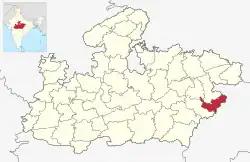Anuppur district
Anuppur District (अनूपपुर) is an administrative district in Shahdol Division of Madhya Pradesh state in central India.
Anuppur district | |
|---|---|
  Top: Narmada Kund at Amarkantak Bottom: Silhara Caves | |
 Location of Anuppur district in Madhya Pradesh | |
| Country | |
| State | Madhya Pradesh |
| Division | Shahdol |
| Headquarters | Anuppur |
| Government | |
| • Lok Sabha constituencies | Shahdol |
| Area | |
| • Total | 3,746 km2 (1,446 sq mi) |
| Population (2011)[1] | |
| • Total | 749,237 |
| • Density | 200/km2 (520/sq mi) |
| Demographics | |
| • Literacy | 69.08 per cent |
| • Sex ratio | 975 |
| Time zone | UTC+05:30 (IST) |
| Website | anuppur |
The district has an area of 3,701 km2 (1,429 sq mi), and a population of 749,237 (2011 Census). 309,624 people are from scheduled tribes and 48,376 are scheduled castes. The district is bordered by Manendragarh district of Chhattisgarh state on the east, Gaurela-Pendra-Marwahi district of Chhattisgarh on the southeast, Dindori District of Madhya Pradesh on the southwest, Umaria District of Madhya Pradesh on the west, and Shahdol District on the northwest and north. The administrative headquarters of the district is Anuppur.
The district has one Jawahar Navodaya Vidyalaya, and Indira Gandhi National Tribal University, a central university at Amarkantak.
Kotma is the largest town and oldest municipality in Anuppur district and also this town is mineral capital of Anuppur district.
The district was created on 15 August 2003 out of Shahdol District. It is part of Shahdol Division.
Anuppur district is mostly hilly and forested. The Narmada River originates from the hill of Amarkantak in the Maikal Hills, and the Son River originates nearby. Almost the entirety of the district is in the Ganga basin, while a small portion in the south in the Narmada basin.
History
Early history of Anuppur district is not clearly chronicled. Anuppur is a newly created district out of erstwhile Shahdol district. By local belief the area of the district was the capital of king Virat. Likewise Amarkantak is associated with rishis Bhrigu, Markandeya etc. as well as Pandava brothers. The north of Son river is believed to be ruled by Magadh empire. The rulers of Mekala who seem to have come under the overlordship of the Vakatakas were known as the Panduvanshis of Mekala. The old country of Mekala lay about the present Amarkantak Hills and its name can be traced in the hills of the Maikal range. Some historians think that Mekala was a small tribe living in the tract of country, comprising the modern Amarkantaka hill and the surrounding territory.
The Bhonsles of Nagpur built the Narmada temple. Maharaja Narendra Prasad Singh belonging to the Chauhan dynasty of Singrauli constructed the outer boundary wall of the temple complex. The Kalchuris constructed the Machendranath and the Patleshwar temple at Amarkantak. These references establish that the district was ruled by Bhonsles of Nagpur and also Kalchuris earlier.
Demographics
| Year | Pop. | ±% p.a. |
|---|---|---|
| 1901 | 128,297 | — |
| 1911 | 146,726 | +1.35% |
| 1921 | 136,290 | −0.74% |
| 1931 | 164,224 | +1.88% |
| 1941 | 187,591 | +1.34% |
| 1951 | 205,240 | +0.90% |
| 1961 | 249,115 | +1.96% |
| 1971 | 310,763 | +2.24% |
| 1981 | 418,833 | +3.03% |
| 1991 | 556,074 | +2.87% |
| 2001 | 667,155 | +1.84% |
| 2011 | 749,237 | +1.17% |
| source:[2] | ||
According to the 2011 census, Anuppur district has a population of 749,237,[1] roughly equal to the nation of Guyana[3] or the US state of Alaska.[4] This gives it a ranking of 492nd in India (out of a total of 640).[1] The district has a population density of 200 inhabitants per square kilometre (520/sq mi).[1] Its population growth rate over the decade 2001-2011 was 12.35%.[1] Anuppur has a sex ratio of 975 females for every 1000 males,[1] and a literacy rate of 69.08%. 27.39% of the population lives in urban areas. Scheduled Castes and Tribes make up 9.92% and 47.85% of the population respectively. The largest tribal community is the Gonds.[1]
Kotma is the biggest town (Municipality) in Anuppur District and Barbaspur (Chondi) near Bhaloo mada coal mines is the biggest village of the Anuppur district.
Hindus are 91.63%, Muslims are 2.87%. Other religions (traditional tribal religion) are 4.73%.[5]
Education
- Govt. Tulsi College
- Govt. I.T.I. College
- Govt. Polytechnic College
- Indira Gandhi National Tribal University, Amarkantak
- Jawahar Novodaya Vidyalaya
References
- "District Census Hand Book – Anuppur" (PDF). Census of India. Registrar General and Census Commissioner of India.
- "Table A-02 Decadal Variation in Population Since 1901: Madhya Pradesh" (PDF). census.gov.in. Registrar General and Census Commissioner of India.
- US Directorate of Intelligence. "Country Comparison:Population". Archived from the original on June 13, 2007. Retrieved 2011-10-01.
Guyana 744,768
- "2010 Resident Population Data". U. S. Census Bureau. Archived from the original on 2013-10-19. Retrieved 2011-09-30.
Alaska 710,231
- "Table C-01 Population by Religion: Madhya Pradesh". Census of India. Registrar General and Census Commissioner of India. 2011.
- "Table C-16 Population by Mother Tongue: Madhya Pradesh". Census of India. Registrar General and Census Commissioner of India.